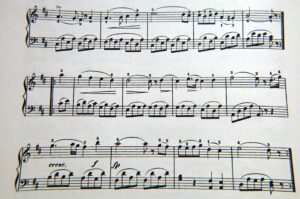Questions abound concerning the A=440 concert pitch… What is it? When did it become standard? What’s the truth about it? Is it harmful? Many more questions float about waiting for answers that make sense. Some people discussing musical subjects don’t understand music theory or read sheet music. Because of that, there’s a lot of incorrect information spewed out all over the Internet. Lots of great musicians do NOT read music. However, to understand theoretical musical concepts, the ability to read music is a requirement. My research also forces me to refresh some theory basics that I tried to forget as a music major in college.
I’m thankful to the people who keep sending me videos and articles! It helps to understand what questions still need answered. First off, it’s necessary to understand the difference between concert pitch and temperament. If you’re not familiar with those, please read the articles. They are NOT the same even though non-musicians (and musicians alike) tend to interchange their definitions.
What is A=440?
A=440 simply means that the A above middle C (2nd space A on the treble clef) is tuned to the frequency of 440 Hz. Once that note is tuned, all the rest of the notes on an instrument are automatically adjusted to sound good with that A. Modern instruments use “equal temperament” which simply means the distance between every note is exactly the same ratio. Basically, you tune one note and the rest of the notes follow suit. It’s like going into a Microsoft Word document, highlighting the entire document and changing the font so every letter is the same font.
When did A=440 become standard?
This is the question that has the most wrong answers across Internet land. Based on musical instruments that are in museums across the world, tuning forks, piano tuner journals and manuals, we have a pretty good idea of what concert pitches were used from the time of Bach (1600’s) to our current date. In a nutshell, A=440 became standard in the US about 1920. The ISO set the world standard to A=440 in 1939. With the mind of a musician, I understand that higher concert pitches are heard better. It would make sense that prior to the era of sound amplification, outdoor performances could be heard when the instruments were tuned to higher concert pitches.

Image by Pixabay
The early 1900’s was the highlight of the military band era with John Philip Sousa as the main figure in this movement. Now, drum and bugle corps are popular in some circles. Microphones aren’t used on a football field or in a parade in order to hear the band. Instruments are built for optimal amplification in these circumstances. The A=440 concert pitch came about during the height of military bands so my musician mind understands the need for the band to be heard. Blastissimo is a good start but when the concert pitch is adjusted with instruments built to those specifications that create more sound, it’s a “chop saver” for band members.
It also makes sense that European countries favored lower concert pitches. Military bands were more popular in the US and UK. They are the two countries that used higher concert pitches. When the ISO (International Organization for Standardization) met in 1939 to create a standard world-wide concert pitch, each nation sent a delegate to vote. Obviously, more countries voted in favor of A=440. Read the article on Hitler and the A=440 for information on any conspiracy theories surrounding that decision.
Where’s the truth?
The most recent bit of information that came via a video is the report that A=440 was standardized in 1950 in the US and shortly after that, rock music was born. The point in the video was that A=440 is harmful. The video was put out by a well respected (and a good player!) non-music-reading musician. I also find many videos that discuss the “ancient” solfeggio frequencies and what they’re supposed to be. I won’t go into that here since I have three other blog posts on that subject. I will say that information concerning these frequencies comes from musicians and people who don’t read music and have no way of knowing if the frequencies accurately represent what we know historically actually occurred.

Image by Pixabay
In order to find truth concerning technical musical matters, one must look to reputable sources. The authors of those sources must have training where there’s an understanding of music theory and history, along with the ability to read music. I’ve yet to find anyone who doesn’t read music fully understand concert pitch, temperament, intervals, and how musical frequencies work together. For example, a trained musician could tell you what this piece of sheet music sounds like (see image) without playing it first. They’d even be able to tell you what era it was written in and possibly who wrote it. In addition, they’d be able to “sight sing” the melody without the aid of a piano. (Hint…. classical era)
When reading articles or watching videos by people who discuss technical musical details, check the musical training level of the author. Again, not all good musicians (including some studio musicians) can read music. Non-music readers understand playing concepts but generally have minimal knowledge of music theory. Most musical artists, of any genre, list any formal training in their bios because they know it adds credibility to their musical discussions. However, there are many “play by ear only” people who are better musicians than those with formal training. It’s all about patience, practice, and perseverance. Lastly, if an author doesn’t cite sources but only what they’ve heard through the grapevine (sing along now…), chances are that the information is lacking accuracy.
Anyone can call themselves a musicologist – one who is trained in the academic study of music rather than music performance. However, any reputable musicologist also reads music. Even someone who calls themselves a music historian should read music and understand music theory. Musical acoustics specialists also read music. I’m not trying to be an academic snob with my statements. What I point out is meant to help my readers know how to find accurate information. I honor the “non-music-reading-musicians” because they can do things that I can’t. On the other end of the spectrum, I can do things they can’t. Depending on what you’re looking for determines who you go to for information. If I want someone to replace my electrical panel in the house, I’m best off going to a certified electrician. If you want good information on the inner workings of music, you’re best to get that information from someone with an advanced degree in music.
Is A=440 harmful?
In the article about Hitler and the A=440, I go into further detail on this question. My short answer is that anything can be harmful if used in the wrong manner. Take guns for example since it’s a hot topic in the world today. I know people who hunt every year and what they kill puts food on the table for the family. On the other end of that spectrum, we have people with ill intentions who have access to guns. Guns are only harmful based on the user’s intent. The same is true with musical frequencies. Yes, some frequencies are found to have healing properties but when adding healing intent into those frequencies, it makes the frequency even more powerful. Intent has to be part of the recipe! Pair intent with a frequency and it’s like a car with a turbo booster where it becomes more powerful. A=440 is no more harmful than any other concert pitch. As a classical musician, I’ve played in the A=440 concert pitch my whole life and had some truly amazing experiences while playing classical music. On the other hand, my intent is that the spontaneous music I create (in tunings other than A=440) is soothing, peaceful, healing, and comforting for listeners.
I will add here that sound amplification does affect how people respond to music. If the quality of the equipment is poor (like at a recent conference I attended), music in higher concert pitches is going to sound and feel harsher. There are people who are sensitive to some tunings more than others. Why? No two people are built the same. That’s evident in our DNA since only identical twins have the same DNA (so I’ve heard). There are many factors in how we respond to frequencies. There are also some frequencies that scientists find more helpful to our bodies than others. Music in the A=432 concert pitch appears to be good for the body as I outline in various articles on this website.
The moral of this story? Don’t believe everything you read, see, and hear. Check the sources to make sure they’re credible and if something doesn’t make sense, ask someone with knowledge on the topic. The other bit is to not be afraid of doing your own research. As a trained musician, I still go back and double check the accuracy of what I say when there’s a even a sliver of doubt concerning the answer. Sometimes I still get it wrong but when I do, you’ve probably noticed that I go back and update the blog post/article.
Keep sending materials, especially if it doesn’t make sense to you! As I often tell my students, “Thus sayeth Dr. Del.” I hope you’ve found this information helpful.
Del
© 2019 by Del Hungerford
[mailerlite_form form_id=2]


[…] much debunked this statement in my article on the A=440 concert pitch. To read more about that, CLICK HERE. First off, we must understand that only keyboard and fretted instruments actually stay within a […]